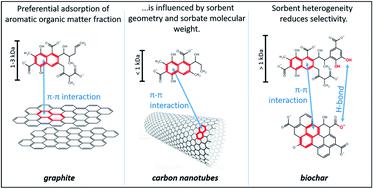当前位置:
X-MOL 学术
›
Environ. Sci.: Processes Impacts
›
论文详情
Our official English website, www.x-mol.net, welcomes your
feedback! (Note: you will need to create a separate account there.)
The importance of aromaticity to describe the interactions of organic matter with carbonaceous materials depends on molecular weight and sorbent geometry.
Environmental Science: Processes & Impacts ( IF 4.3 ) Pub Date : 2020-08-17 , DOI: 10.1039/d0em00267d Stephanie Castan 1 , Gabriel Sigmund 1 , Thorsten Hüffer 1 , Nathalie Tepe 1 , Frank von der Kammer 1 , Benny Chefetz 2 , Thilo Hofmann 1
Environmental Science: Processes & Impacts ( IF 4.3 ) Pub Date : 2020-08-17 , DOI: 10.1039/d0em00267d Stephanie Castan 1 , Gabriel Sigmund 1 , Thorsten Hüffer 1 , Nathalie Tepe 1 , Frank von der Kammer 1 , Benny Chefetz 2 , Thilo Hofmann 1
Affiliation

|
Dissolved organic matter (DOM) is ubiquitous in aquatic environments where it interacts with a variety of particles including carbonaceous materials (CMs). The complexity of both DOM and the CMs makes DOM–CM interactions difficult to predict. In this study we have identified the preferential sorption of specific DOM fractions as being dependent on their aromaticity and molecular weight, as well as on the surface properties of the CMs. This was achieved by conducting sorption batch experiments with three types of DOM (humic acid, Suwannee River natural organic matter, and a compost extract) and three types of CMs (graphite, carbon nanotubes, and biochar) with different geometries and surface complexities. The non-adsorbed DOM fraction was analyzed by size exclusion chromatography and preferentially sorbed molecular weight fractions were analyzed by UV/vis and fluorescence spectroscopy. All three sorbent types were found to preferentially sorb aromatic DOM fractions, but DOM fractionation depended on the particular combination of sorbent and sorbate characteristics. Single-walled carbon nanotubes only sorbed the smaller molecular weight fractions (<1 kDa). The sorption of smaller DOM fractions was not accompanied by a preference for less aromatic compounds, contrary to what was suggested in previous studies. While graphite preferentially sorbed the most aromatic DOM fraction (1–3 kDa), the structural heterogeneity of biochar resulted in reduced selectivity, sorbing all DOM > 1 kDa. The results explain the lack of correlation found in previous studies between the amount of aromatic carbon in a bulk DOM and its sorption coefficient. DOM sorption by CMs was generally controlled by DOM aromaticity but complex sorbent surfaces with high porosity, curvatures and functional groups strongly reduced the importance of aromaticity.
中文翻译:

芳香性对描述有机物与含碳物质相互作用的重要性取决于分子量和吸附剂的几何形状。
溶解有机物(DOM)在水生环境中无处不在,在水中它与包括碳质材料(CMs)在内的各种颗粒相互作用。DOM和CM的复杂性使得DOM-CM交互难以预测。在这项研究中,我们已经确定了特定DOM组分的优先吸附取决于它们的芳香性和分子量,以及CM的表面性质。这是通过使用三种类型的DOM(腐殖酸,Suwannee河天然有机物和堆肥提取物)和三种类型的CM(石墨,碳纳米管和生物炭)进行吸附分批实验而实现的,这些CM具有不同的几何形状和表面复杂性。通过尺寸排阻色谱法分析未吸附的DOM级分,并通过UV / vis和荧光光谱法分析优选吸附的分子量级分。发现所有三种吸附剂类型均优先吸附芳族DOM馏分,但DOM馏分取决于吸附剂和被吸附物特性的特定组合。单壁碳纳米管仅吸收较小的分子量分数(<1 kDa)。与先前研究中所暗示的相反,较小的DOM组分的吸附并没有伴随着对芳香族化合物的偏爱。石墨优先吸附最芳香的DOM组分(1-3 kDa),而生物炭的结构异质性导致选择性降低,所有DOM> 1 kDa都被吸附。结果解释了以前的研究中发现,在本体DOM中的芳香碳含量与其吸附系数之间缺乏相关性。CM对DOM的吸附通常由DOM芳香性控制,但是具有高孔隙率,曲率和官能团的复杂吸附剂表面强烈降低了芳香性的重要性。
更新日期:2020-09-23
中文翻译:

芳香性对描述有机物与含碳物质相互作用的重要性取决于分子量和吸附剂的几何形状。
溶解有机物(DOM)在水生环境中无处不在,在水中它与包括碳质材料(CMs)在内的各种颗粒相互作用。DOM和CM的复杂性使得DOM-CM交互难以预测。在这项研究中,我们已经确定了特定DOM组分的优先吸附取决于它们的芳香性和分子量,以及CM的表面性质。这是通过使用三种类型的DOM(腐殖酸,Suwannee河天然有机物和堆肥提取物)和三种类型的CM(石墨,碳纳米管和生物炭)进行吸附分批实验而实现的,这些CM具有不同的几何形状和表面复杂性。通过尺寸排阻色谱法分析未吸附的DOM级分,并通过UV / vis和荧光光谱法分析优选吸附的分子量级分。发现所有三种吸附剂类型均优先吸附芳族DOM馏分,但DOM馏分取决于吸附剂和被吸附物特性的特定组合。单壁碳纳米管仅吸收较小的分子量分数(<1 kDa)。与先前研究中所暗示的相反,较小的DOM组分的吸附并没有伴随着对芳香族化合物的偏爱。石墨优先吸附最芳香的DOM组分(1-3 kDa),而生物炭的结构异质性导致选择性降低,所有DOM> 1 kDa都被吸附。结果解释了以前的研究中发现,在本体DOM中的芳香碳含量与其吸附系数之间缺乏相关性。CM对DOM的吸附通常由DOM芳香性控制,但是具有高孔隙率,曲率和官能团的复杂吸附剂表面强烈降低了芳香性的重要性。











































 京公网安备 11010802027423号
京公网安备 11010802027423号